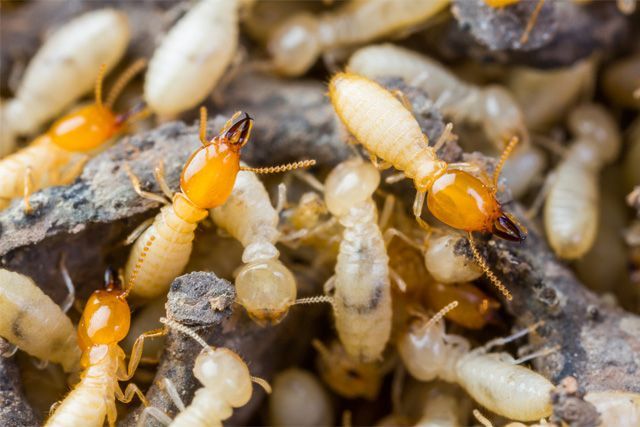Wood Destroying Insects

What Are Wood-Destroying Insects?
While termites are the most common wood-destroying insects, carpenter ants, and carpenter bees are also dangerous to Hampton Roads homes.
Termites are the most destructive of these common pests, with carpenter ants following and carpenter bees coming in last. Termites and carpenter ants live in large colonies, whereas carpenter bees are solitary insects. These bees bore holes into the wood to nest.
Are Wood-Destroying Insects Dangerous?
Depending on the species and severity of the infestation, wood-destroying pests can cause dangerous damage; this is especially true for termites because they eat wood. Depending on the colony's size and how long they have been there, termites can lead to collapses and other structural weaknesses.
Structural Damage: Termites, as well as other wood-destroying insects like carpenter ants and Powderpost Beetles, can compromise the structural integrity of buildings. They feed on the cellulose found in wood, weakening the material over time. In severe infestations, this can lead to structural failures, such as collapses or compromised load-bearing elements.
Financial Impact: The damage caused by wood-destroying insects can result in significant financial losses for property owners. Repairing or replacing damaged structural components can be costly, and in some cases, insurance may not cover termite-related damage.
Hidden Infestations: Wood-destroying insects often operate in concealed areas, making it challenging to detect infestations in the early stages. By the time visible signed of damage appear, the extent of the problem may already be substantial. Regular inspections and preventive measures are crucial to identifying and addressing infestations before they escalate.
Health Risks: While wood-destroying insects primarily target wooden structures, some species may also pose indirect health risks. For example, carpenter ants can create nests in damp or decaying wood, potentially contributing to mold growth. Mold can lead to respiratory issues and other health concerns for occupants.
Long-Term Consequences: If left untreated, wood-destroying insect infestations can have long-term consequences for a property. Ongoing damage may compromise the resale value of the structure, and potential buyers may be deterred by the history of pest issues.
Preventive Measures: Implementing preventive measures is essential in mitigating the risks associated with wood-destroying insects. This includes regular inspections, addressing moisture issues that attract pests, using treated wood or applying insecticides, and maintaining a barrier between soil and wooden structures.
Why Do I Have Wood-Destroying Insects?
Wood-destroying insects can invade homes for various reasons, one of the most common reasons is that moisture issues have not been fixed. Some more common reasons you may have these insects could be from: Wood-To-Ground contact, Decaying Wood, Firewood Storage, Landscaping Choices, Lack of Regular Inspections and Geographical Factors. Unfortunately, with these pests, you may not realize they are there right away, so they can be causing damage for some time before being addressed. Contact our team today for a thorough inspection of your home or business.
Where Will I Find Wood-Destroying Insects?
While there are many different termites, the most common are subterranean termites. These termites don't live inside wood because they require a much higher moisture level than other species. To ensure they get the moisture needed, subterranean termites live underground and create mud tubes, which also protect them from predators, to travel back and forth from food to nest. You'll find these mud tubes around the foundation and a few feet off the ground.
Conversely, carpenter ants and carpenter bees don't consume wood but live inside it. This ant species will make its way inside through cracks in the foundation and exterior walls. Once inside, they can create galleries in many places, such as wall voids, door and window frames, chimneys, and other places where there might be moisture issues. Carpenter bees tend to stay outside where they infest decks, outside furniture, windowsills, and other similar locations.
How Do I Get Rid Of Wood-Destroying Insects?
When it comes to wood-destroying insects, assessing the damage they cause and properly removing them are no easy tasks. Because of this, you can rely on our experts at Diamond Exterminators and Crawlspace Solutions to do these jobs for you.
Our termite control and inspection services are one way you can protect your home against these kinds of pests. Give us a call at Diamond Exterminators and Crawlspace Solutions to learn about our home pest control and commercial pest control services to help Hampton Roads residents keep wood-destroying insects under control.
How Can I Prevent Wood-Destroying Insects In The Future?
The best way to prevent wood-destroying insects is by eliminating the factors that make your home and property so attractive to them in the first place. You can do this by:
- Rectifying any excess water and moisture issues such as leaks, poor ventilation, moisture collecting around the foundation, and damaged moisture barriers.
- Replace or properly treat water-damaged and decaying wood.
- Removing entryways such as cracks in the foundation.
Call us at Diamond Exterminators and Crawlspace Solutions for year-round protection against termites, carpenter ants, and carpenter bees!
Request Your Free Inspection
Complete the form below to schedule your no-obligation inspection.

